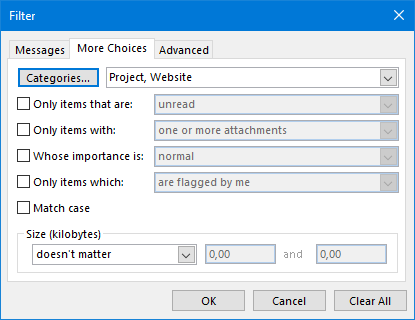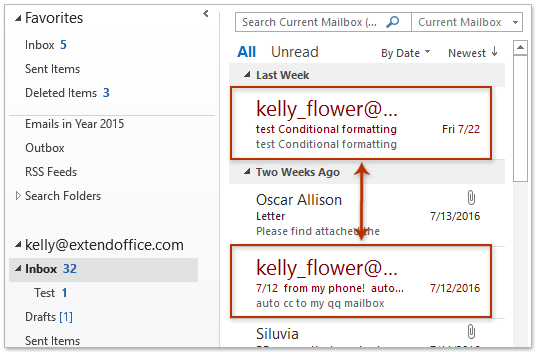

For instance, when in a higher listed rule the font color is set to “Auto” the color of a lower rule will apply.

A lower listed rule can append the formatting of a higher listed rule if the formatting is not defined. The higher listed rules takes precedence over the lower ones.

View-> Arrange By-> Custom…-> Automatic Formatting… Open the Conditional Formatting dialog:.Links to more Conditional Formatting examplesĬreating a Conditional Formatting rule can be done in the following way.This guide will help you on your way to get yourself familiar with the Conditional Formatting options with 8 color coding examples which might be useful to you as well.Ĭonditional Formatting usage in the Message List. The “Conditional Formatting” feature may look complex at first but creating color coding rules is actually fairly easy and quite powerful when used the right way. Show overdue emails and tasks in a red font.Show expired emails and completed tasks in a grey and strikethrough font.Show unread emails in a blue and bold font.You may actually already know Conditional Formatting without realizing it as it is for instance also being used to: The color coding isn’t just intended to emphasize certain emails but it can also be used to deemphasize certain emails such as newsletters or emails you are only a CC or BCC recipient of. then Automatic Formatting button.The Conditional Formatting feature in Outlook allows you to get organized by automatically color coding your Emails, Calendar items, Contacts and Tasks without the need to apply a Color Category to it or move them to different folders. Video tutorial: Outlook 2010 and newerĬlick on Arrange By to expand the menu and select Custom. To make a copy of the view, choose Save Current view as a New View from the Change View menu. If the original view gets messed up, use the copy and apply it to the folders. You can make a copy of the view thus is recommended if you customized a default view as it's very easy to accidently reset the view. To apply it to other folders, use Change View > Apply Current View to Other Mail Folders to set the view on other folders. Close the dialogs and apply the view when finished.īecause Conditional formatting is part of a view, it may only be applied to the current folder (or to folders using the current view).In this example, I'm going to highlight all messages from. Do not use the From field on the Advanced tab. If you want to filter by email address, not display name, type the address or part of the address in the From field on the Messages tab. Click Add and enter a name for the formatting rule choose your Font.Click Conditional Formatting button (it's called Automatic Formatting in older versions of Outlook.).In all versions, right click on the row of field name (or Arrange By) at the top of the message list and choose Customize (or View Settings). In Outlook 2010 and newer, look for the View Settings button on the View tab. In this example, I'm highlighting messages from a sender in Red then creating a copy of the view so I can show only the messages from that sender.


 0 kommentar(er)
0 kommentar(er)
